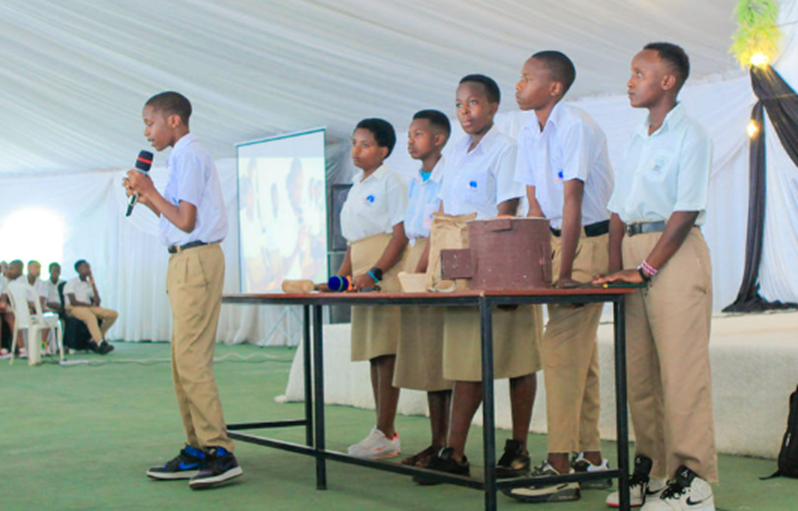A New Generation of Scientific Sustainability in Rwanda
Young Scientists in Rwanda are Leaders of Environmental Sustainability Movement with STEM Innovation Challenge, Sponsored by Clifford Chance Cornerstone Initiative

The New York Academy of Sciences “Green Schools, Green Homes, Green Communities” Innovation Challenge in Rwanda was a great success, engaging the participation of 909 local secondary school students from across Kigali, working in 163 teams to create research-driven solutions to environmental problems faced in their community. The Spring 2023 Innovation Challenge, organized by the New York Academy of Sciences in partnership with Association Mwana Ukundwa (AMU), encouraged young scientists aged 13-17 in Rwanda’s capital city of Kigali to design an innovative, sustainable approach to address an environmental challenge in the places where they live and study. Sponsored by the Clifford Chance Cornerstone Initiative, and building off the widespread enthusiasm for the Spring 2022 Innovation Challenge on Urban Gardens in Rwanda, this challenge latest green challenge called for creative, practical solutions that could be implemented in Rwandan schools, homes, and communities to turn environmental challenges into sustainable growth.
The students from 12 public schools in Kigali who took part in the Green Schools, Green Homes, Green Communities Innovation Challenge contributed to raising awareness of the environmental challenges facing Rwanda and the rest of the world. They researched problems related to environmental sustainability, brainstormed with teammates to design and test creative solutions, and created scientific presentations to communicate their ideas to their peers and community. Each team was guided in their efforts by dedicated teachers from the twelve participating schools who served as Mentors to the students and supported them through developing their research projects.
Young Scientists Innovate Practical Solutions through Research and Creativity
Over the past two decades, Rwanda has become a global leader in sustainable development after adopting economic growth strategies that incorporate environmental protection and climate change adaptation. As a small, landlocked country, Rwanda faces numerous challenges due to climate change, the unequal distribution of potable water and the over-exploitation of natural resources.
A growing number of individuals, young people in particular, are exploring innovative ways to address these problems and create meaningful change at the local and community level. As emerging leaders in the movement to prevent environmental degradation and promote sustainability, the young scientists participating in the challenge demonstrated that through ingenuity and hard work, practical solutions can be found to make homes, schools and communities greener and reduce the pressure on precious natural resources and the environment.
The Winning Team and selected Runner-Up Teams were invited to present their innovative solutions at the Open Day celebration for the challenge held at AMU. They showcased their projects to an audience of over a thousand people including their families, all of the students in the challenge, educators and school leaders from the participating schools, and government officials, including the Coordinator of the Joint Action Development Forum from the Office of the Mayor in Kigali and the Director of Education for the entire Kicukiro district. The scientific solutions from these students have been taken up and used by residents across Rwanda to improve wellbeing, public health, and economic and environmental sustainability.
Winning Team: Sustainable Resource Management and Conservation for Achieving Green Homes and Green Communities
Team Members: Clarisse (Team Lead), Leandre, Joyeuse, Mucyo, Ayubu, Jolie
Mentor: Nizeyimana Bonaventure
The winning team tackled the environmental and socioeconomic impacts of traditional cooking methods, which rely heavily on firewood. The widespread use of wood for cooking contributes to deforestation and produces harmful gas emissions. Wood burning also causes air pollution within the home, which has a detrimental impact on human health and is linked to pneumonia, lung cancer and other severe health conditions.
The team members’ solution was to build an innovative stove, using affordable materials, to reduce fuel consumption. After conducting research to come up with an optimal design, the students crafted a stove made of iron sheeting and lined with clay. They incorporated an electronic fan, which enhances combustion efficiency. After testing their prototype, the team found that their device significantly reduces fuel consumption, thus limiting the impact on the environment. Shorter cooking times and better heat control also improve indoor air quality while easing the cooking burden for household members. The team won first place for this original project, which helps combat deforestation, the health impacts of air pollution and the inefficient use of natural resources.
Runner-Up Team: Green Surrounding Us
Team Members: Emerance (Team Lead), Leogad, Diane, Solange, Alliance
Mentor: Baseka Didier
Many people in Rwanda suffer from the searing summer heat and lack of cool air indoors, whether in houses or at school where it affects students and administration employees. In the course of their research, the team members found out that a majority of people around the world experience lack of access to indoor fresh, cool air. “I was very interested in this project. We had fun and did hard work in the group, brainstorming and searching for a solution,” says team member Alliance. After collecting information online and interviewing local environmental experts, the team members designed and produced a light, portable fan with blades made of discarded cardboard. Powered by a rechargeable battery and equipped with an on/off switch, the fan provides hours of cool relief, and the reused cardboard does not end up in landfill.
Runner-Up Team: Amazing Green
Team Members: Nice (Team Lead), Jeannette, Ange Scovia, Chanisse, Rosine, Beatrice
Mentor: Baseka Didier
The students in this team focused on improving their school environment by tackling two challenges at once: reducing waste and creating storage to improve order in the classroom. “Me and my teammates have gained many things from this project,” says team leader Nice. “Working together, we have learned to be part of society and care about others’ attitudes.” Collecting plastic bottles and old cardboard to prevent them from littering the environment, the team members upcycled these materials by crafting shelf racks to store documents and other school supplies. The students applied their math and science skills to design the racks and used the plastic bottles to prop up cardboard shelves. “I was given the responsibility to find cardboard in my group and I really studied to create teamwork in the group,” says team member Ange Scovia. “I had fun and laughed a lot during this project.” The sturdy shelf racks were designed to bear a weight of up to 4 kilograms and last 3 to 5 years. As proof of concept, the team produced a prototype, demonstrating that their model is both easy and inexpensive to replicate.
Runner-Up Team: Sustainable Life in the Green Community from Discarded Material
Team Members: Jean-Marie (Team Lead), Fils, Anna Jali, Emmanuel, Naomi, Amani
Mentor: Rubarema Maurice
The six team members first studied the impact of waste on the environment by observing the evolution of different types of waste on two small plots of land: they saw that organic kitchen waste decayed and turned into compost that contains important nutrients for plants, but plastic containers and plastic bags remained intact, cluttering the ground and preventing plant growth by blocking access to carbon dioxide and sunlight. After consulting experts, the team came up with three practical uses for recycled plastic containers. First, they used old jerrycans to grow plants, particularly vegetables — an approach that enables households with limited access to land to supplement their diet with healthy, home-grown food. The jerrycans were also utilized as composting receptacles to turn kitchen waste into nutrient-rich fertilizer and as containers for smaller plastic waste. “Before doing this challenge, I was not good at working collaboratively in a team,” explains team member Emmanuel. “This challenge made me realize that working together leads to the best solutions because different ideas are collected together to create the main idea.”
Runner-Up Team: Terracing to Prevent Soil Erosion
Team Members: Ally (Team Lead), Anaclet, Nelly Chanella, Jean-Baptiste, Fabrice, Fidele
Mentor: Karangwa Adiel
Soil erosion is a problem caused by rainwater and human activities such as agriculture and deforestation. The members of this team were inspired to tackle this pressing issue largely because soil erosion caused by an inadequate drainage system threatens their school. “With the team I found new friends and I did my best to give ideas and contribute to the design of the solution,” says team member Jean Baptiste. After visiting the site and building model terraces on the hillside, the students found that terracing reduces the steepness of the slope and slows down the water flow, preventing rain from washing away the topsoil and crucial nutrients. In addition, planting fruit trees and crops on the terraces contributes to a greener school environment and provides healthy food. In the course of the project, participants acquired both knowledge and self-confidence. “I was very shy at the beginning of the project,” says team member Nelly Chanella, “but now I can engage in constructive discussions.”
Runner-Up Team: Green Operation
Team Members: Liliane (Team Lead), Yvan, Zainah, Djuma, Elisaa, Diane
Mentor: Musenge Hosiane
This team focused on the water pollution caused by the ever-growing use of plastic bottles, which are almost indestructible and often end up in the ocean. When the bottles do eventually decompose, the plastics break down into micro-particles that seep into the soil and drift into the waterways, causing harm to humans and other animals. To reduce waste and water pollution, the six team members sought innovative ways to reuse plastic bottles and jerrycans while also improving their school environment. They turned used plastic containers into pencil holders and receptacles for school supplies to keep classrooms well organized and clean. Their efforts also showed their fellow students how to recycle effectively to reduce water pollution and protect the environment. “Being a first-year member of the New York Academy Innovation Challenge has been an unforgettable journey that has helped me hone my skills and make friends that will last a lifetime,” says team leader Liliane, adding, “I met hardworking individuals who helped me improve my own skills and taught me many valuable lessons in teamwork and analytical thinking.”
